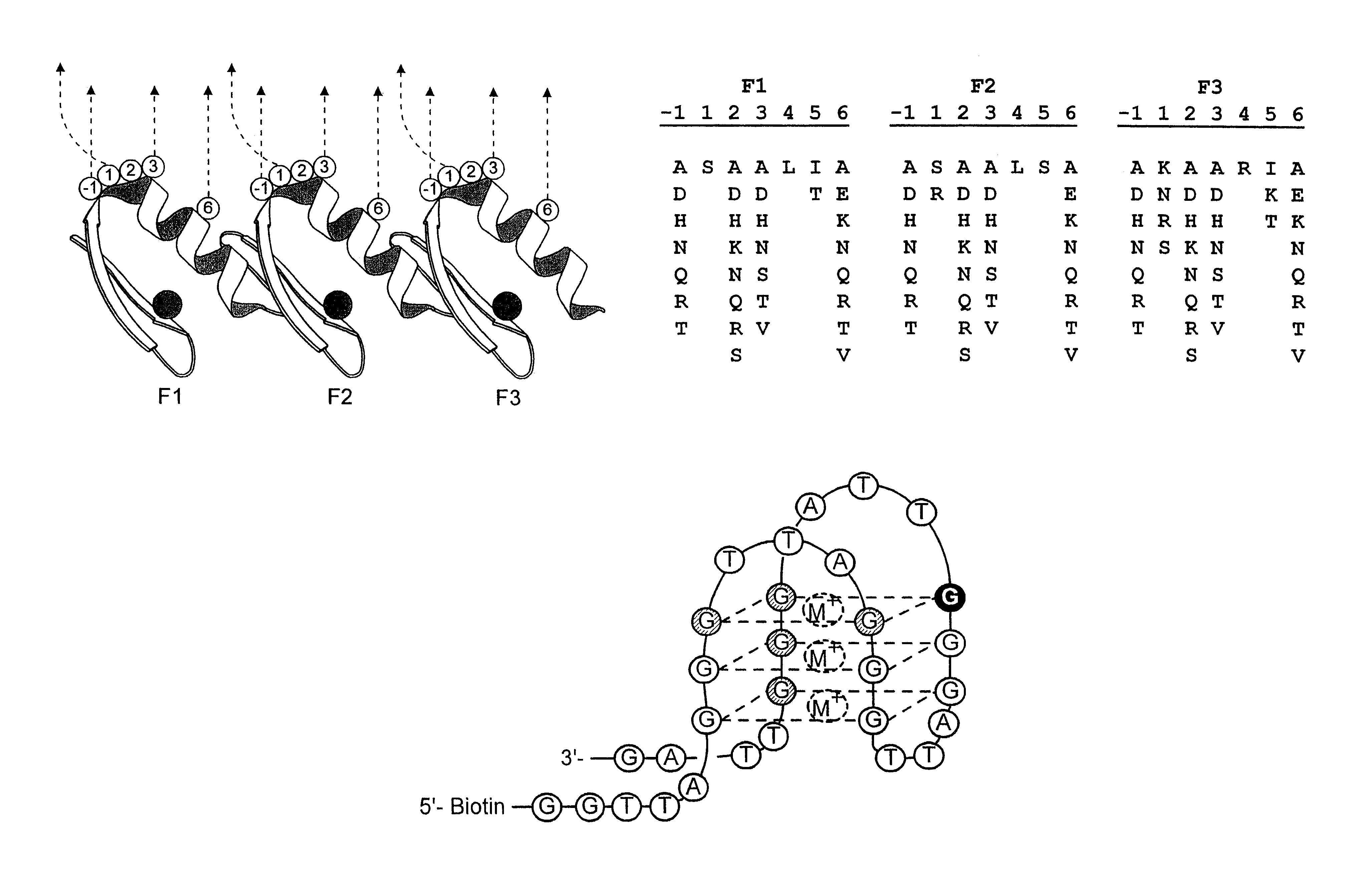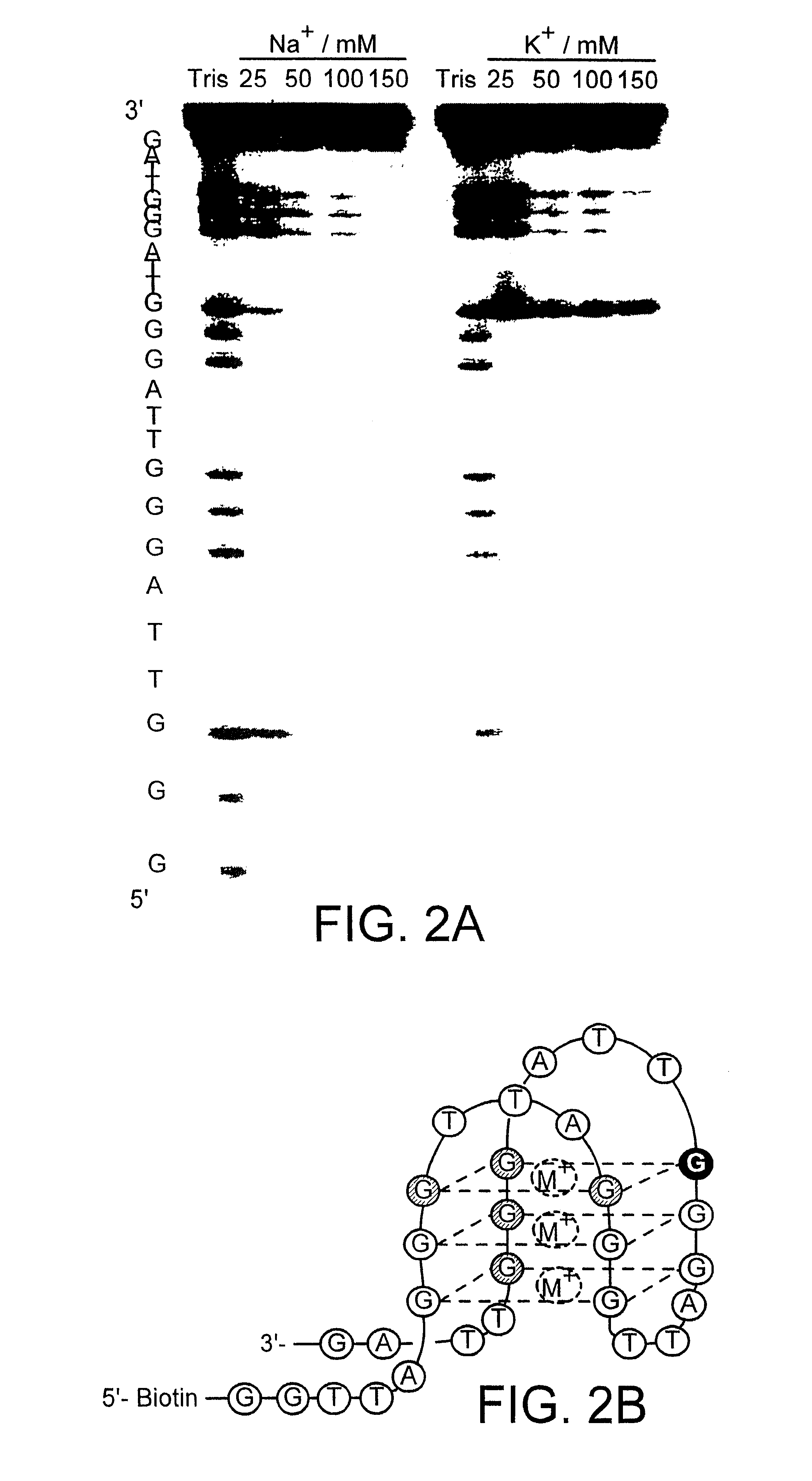Zinc finger polypeptides capable of binding DNA quadruplexes
a zinc finger and polypeptide technology, applied in the direction of peptide/protein ingredients, peptide sources, instruments, etc., can solve the problems of non-conventional dna structure, complex recovery of genomic dna encoding the nucleic acid binding protein,
- Summary
- Abstract
- Description
- Claims
- Application Information
AI Technical Summary
Benefits of technology
Problems solved by technology
Method used
Image
Examples
example 1
Production of Molecules Binding G-quadruplex Structures
In this Example, DNA-binding proteins of the zinc finger family are engineered to bind specifically to a telomeric (i-quadruplex nucleic acid structure.
A zinc finger library is screened for molecules that bind to an oligonucleotide containing the human telomeric repeat sequence in the G-quadruplex conformation. The selected molecular clones exhibit amino acid homologies (consensus sequences). Without wishing to be bound by theory, this suggests that the molecules have analogous modes of binding. Binding is both sequence-dependent and structure-specific. This is the first example of a designed molecule that binds to G-quadruplex DNA. Further, this represents a new type of binding interaction for a zinc finger protein molecule.
G-quadruplex DNA Ligand Preparation
It has been previously reported that the human telomeric sequence (5'-GTTAGG-3')n forms G-quadruplex structures in vitro (Balagurumoorthy, P., Brahmachari, S. K., Mohanty, ...
example 2
Molecules According to the Invention Selectively Bind G-quadruplex DNA
The nucleic acid binding properties of zinc finger molecules produced according to the invention may be analysed.
Characterisation of the binding properties of molecules Gq1-4 (see Example 1) shows that they do indeed behave very similarly. Therefore, only one phage clone (Gq1) is used to explore the binding specificity in more detail in this Example.
Phage ELISA is performed using analogues of the Biotin-Htelo oligonucleotide which contain adenine or inosine substitutions for critical guanine residues which are important for G-quadruplex formation (see Table 1). Although adenine and inosine are structurally related to guanine, both destabilise G-quadruplex formation (Williamson. J. R., Raghuraman, M. K., & Cech, T. R. (1989) Cell 59, 871-880.). The adenine substitution leads to a hydrogen bonding arrangement that is incompatible with G-quartet formation, while inosine lacks an N-2 exocyclic amino group required for...
example 3
Use of Molecules According to the Invention in a Telomerase Assay
Telomerase activity may be assayed according to the invention using the following method.
Telomerase template primers are bound to ELISA wells by biotin-streptavidin linkage as described in Example 2. These primers are non-G-rich and are not bound by Gq1*.
Test extracts are added to wells in telomerase extension buffer.
The test extracts may contain telomerase activity. Such activity would cause primer extension through the addition of repeats of the sequence [(GGGTTA)n].
A telomerase extension reaction is carried out in telomerase extension conditions.
Telomerase products [(GGGTTA)n] are detected by ELISA as described in Example 2.
This method provides a convenient and rapid technique for the assay of telomerase activity, and / or the detection of candidate telomerase activities.
PUM
| Property | Measurement | Unit |
|---|---|---|
| pH | aaaaa | aaaaa |
| pH | aaaaa | aaaaa |
| apparent ELISA dissociation constant | aaaaa | aaaaa |
Abstract
Description
Claims
Application Information
 Login to View More
Login to View More - R&D
- Intellectual Property
- Life Sciences
- Materials
- Tech Scout
- Unparalleled Data Quality
- Higher Quality Content
- 60% Fewer Hallucinations
Browse by: Latest US Patents, China's latest patents, Technical Efficacy Thesaurus, Application Domain, Technology Topic, Popular Technical Reports.
© 2025 PatSnap. All rights reserved.Legal|Privacy policy|Modern Slavery Act Transparency Statement|Sitemap|About US| Contact US: help@patsnap.com



